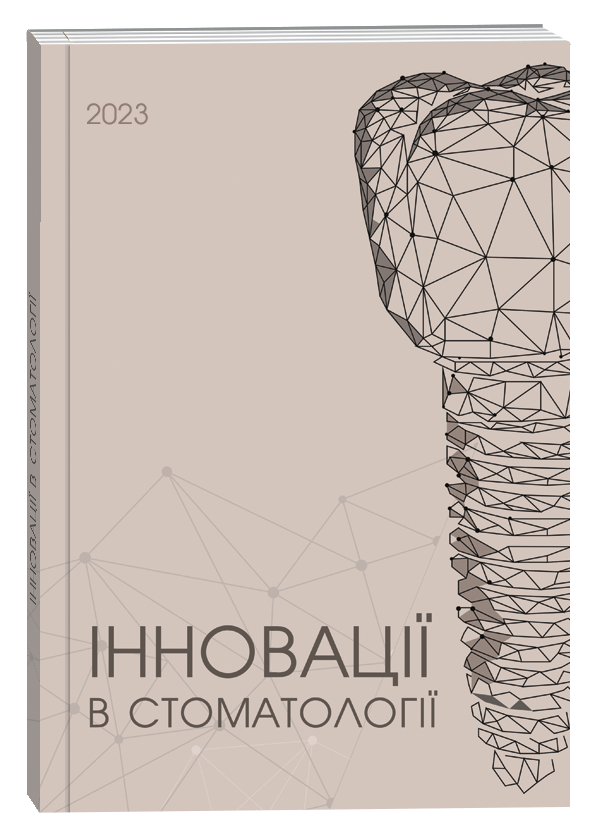MODERN VIEWS ON THE INFLUENCE OF MALOCCLUSION AND ORTHODONTIC TREATMENT ON THE DEVELOPMENT OF TEMPOROMANDIBULAR DISORDERS (LITERATURE REVIEW)
DOI:
https://doi.org/10.35220/2523-420X/2025.2.29Keywords:
malocclusion, temporomandibular disorders, orthodontic treatmentAbstract
This article presents a literature review of publications on current views on the influence of malocclusion and orthodontic treatment on the development of temporomandibular disorders. Purpose of the study: based on scientific research data, to establish the probability of the impact of occlusion disorders and orthodontic treatment on the development of temporomandibular disorders. Materials and methods. The bibliosemantic method was used to clarify the state of the problem, study the analysis of the results of previous scientific research based on literature sources and electronic resources.Information search and analysis of scientific sources were carried out using the scientometric databases Web of Science, PubMed, Google Scholar for the last 10 years. Results: As a result of the search and analysis of literature sources, the authors of the study concluded that patients with temporomandibular disorders are not recommended to start orthodontic treatment until the symptoms disappear completely. If such symptoms have already appeared during orthodontic treatment, it is necessary to suspend it for the duration of the treatment of temporomandibular disorders, or until the patient's condition improves as much as possible. After the symptoms disappear, orthodontic interventions can be continued according to the original plan or, if necessary, adjusted depending on the patient's condition. Timely detection and treatment of temporomandibular disorders will allow for more predictable orthodontic treatment in the future. Conclusions: According to current scientific research data, there is no convincing connection between the development of temporomandibular disorders and occlusion disorders. When planning orthodontic treatment, especially in adult patients, in order to prevent complications and draw up a correct treatment plan, one of the first steps should be to assess the condition of the TMJ and masticatory muscles.
References
Beaumont, S., Garg, K., Gokhale, A., & Heaphy, N. (2020). Temporomandibular Disorder: a practical guide for dental practitioners in diagnosis and management. Australian dental journal, 65(3), 172–180
Macrì, M., Murmura, G., Scarano, A., & Festa, F. (2022). Prevalence of temporomandibular disorders and its association with malocclusion in children: A transversal study. Frontiers in public health, 10, 860833.
Olliver, S.J., Broadbent, J.M., Thomson, W.M., & Farella, M. Occlusal features and TMJ clicking: a 30-year evaluation from a cohort study. J Dent Res 2020. DOI: 10.1177/0022034520936235
Amer, N.M., Aboalnaga, A.A., Salah Fayed, M.M., & Labib, A.H. (2019). Transverse Malocclusion and Temporomandibular Disorders: Verification of the Controversy. Journal of oral & facial pain and headache, 33(4), 355–361. DOI: 10.11607/ofph.2286
de Paiva Bertoli, F.M., Bruzamolin, C.D., de Almeida Kranz, G.O., Losso, E.M., Brancher, J.A., & de Souza, J.F. (2018). Anxiety and malocclusion are associated with temporomandibular disorders in adolescents diagnosed by RDC/TMD. A cross-sectional study. Journal of oral rehabilitation, 45(10), 747–755. DOI: 10.1111/ joor.12684
Michelotti, A., Rongo, R., Valentino, R., D'Antò, V., Bucci, R., Danzi, G., & Cioffi, I. (2019). Evaluation of masticatory muscle activity in patients with unilateral posterior crossbite before and after rapid maxillary expansion. European journal of orthodontics, 41(1), 46–53. https://doi.org/10.1093/ejo/cjy019
Farronato, G., Giannini, L., Galbiati, G., Sesso, G., & Maspero, C. (2012). Orthodontic-surgical treatment: neuromuscular evaluation in skeletal Class II and Class III patients. Progress in orthodontics, 13(3), 226–236. DOI: 10.1016/j.pio.2012.04.003
Valentino, R., Cioffi, I., Vollaro, S., Cimino, R., Baiano, R., Michelotti A. (2021). Jaw muscle activity patterns in women with chronic TMD myalgia during standardized clenching and chewing tasks. Cranio, 39(2), 157-163. DOI: 10.1080/08869634.2019.1589703.
Manfredini, D., Lombardo, L., & Siciliani, G. (2017). Temporomandibular disorders and dental occlusion. A systematic review of association studies: end of an era?. Journal of oral rehabilitation, 44(11), 908–923. DOI: 10.1111/joor.12531
Alhammadi, M.S., Fayed, M.S., & Labib, A. (2017). Three-dimensional assessment of condylar position and joint spaces after maxillary first premolar extraction in skeletal Class II malocclusion. Orthodontics & craniofacial research, 20(2), 71–78. DOI: 10.1111/ ocr.12141
Kandasamy, S., & Greene, C.S. (2020). The evolution of temporomandibular disorders: A shift from experience to evidence. Journal of oral pathology & medicine : official publication of the International Association of Oral Pathologists and the American Academy of Oral Pathology, 49(6), 461–469. DOI: 10.1111/jop.13080
Gurbanov, V., Bas, B., & Öz, A.A. (2020). Evaluation of Stresses on Temporomandibular Joint in the Use of Class II and III Orthodontic Elastics: A Three- Dimensional Finite Element Study. Journal of oral and maxillofacial surgery : official journal of the American Association of Oral and Maxillofacial Surgeons, 78(5), 705–716. DOI: 10.1016/j.joms.2019.11.022
Michelotti, A., Rongo, R., D'Antò, V., & Bucci, R. (2020). Occlusion, orthodontics, and temporomandibular disorders: Cutting edge of the current evidence. Journal of the World federation of orthodontists, 9(3S), S15–S18. https://doi.org/10.1016/j.ejwf.2020.08.003
Minakuchi, H., Fujisawa, M., Abe, Y., Iida, T., Oki, K., Okura, K., Tanabe, N., & Nishiyama, A. (2022). Managements of sleep bruxism in adult: A systematic review. The Japanese dental science review, 58, 124–136. DOI: 10.1016/j.jdsr.2022.02.004
Manfredini, D., Lombardo, L., Vigiani, L., Arreghini, A., & Siciliani, G. (2018). Effects of invisible orthodontic retainers on masticatory muscles activity during sleep: a controlled trial. Progress in orthodontics, 19(1), 24. DOI: 10.1186/s40510-018-0228-y
Castroflorio, T., Bargellini, A., Lucchese, A., Manuelli, M., Casasco, F., Cugliari, G., Cioffi, I., & Deregibus, A. (2018). Effects of clear aligners on sleep bruxism: randomized controlled trial. Journal of biological regulators and homeostatic agents, 32(2 Suppl. 2), 21–29
Tran, J., Lou, T., Nebiolo, B., Castroflorio, T., Tassi, A., & Cioffi, I. (2020). Impact of clear aligner therapy on tooth pain and masticatory muscle soreness. Journal of oral rehabilitation, 47 (12), 1521–1529. DOI: 10.1111/joor.13088
Schiffman, E., Ohrbach, R., Truelove, E., Look, J., Anderson, G., et al. (2014). Diagnostic Criteria for Temporomandibular Disorders (DC/TMD) for Clinical and Research Applications: recommendations of the International RDC/TMD Consortium Network* and Orofacial Pain Special Interest Group†. Journal of oral & facial pain and headache, 28(1), 6–27. DOI: 10.11607/ jop.1151
Aldayel, A.M., AlGahnem, Z.J., Alrashidi, I.S., Nunu, D.Y., Alzahrani, A. M., Alburaidi, W. S., Alanazi, F., Alamari, A. S., & Alotaibi, R. M. (2023). Orthodontics and Temporomandibular Disorders: An Overview. Cureus, 15(10), e47049. DOI: 10.7759/cureus.47049
Monika, A. Zurfluh, Dimitrios Kloukos, Raphael Patcas, Theodore Eliades (2015). Effect of chin-cup treatment on the temporomandibular joint: a systematic review, European Journal of Orthodontics, 37, 3(1), 314–324. DOI: 10.1093/ejo/cju048
Okeson, J.P. (2020). Management of temporomandibular disorders and occlusion. St. Louis, Missouri: Elsevier.








